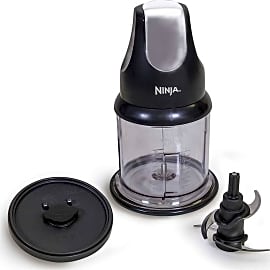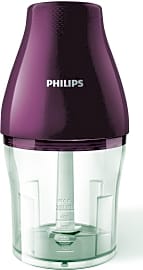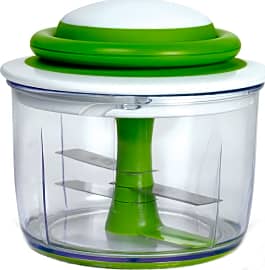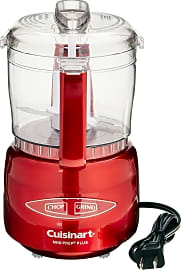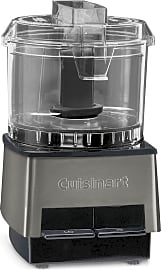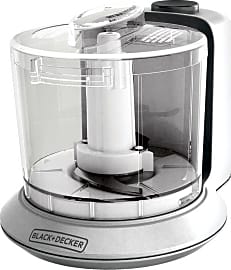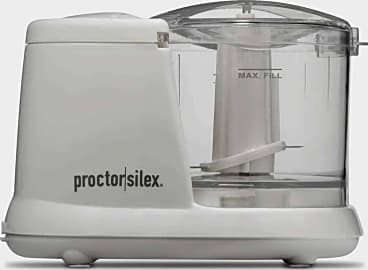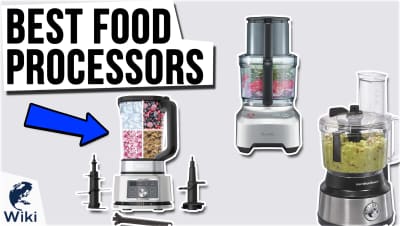The 10 Best Mini Food Processors

This wiki has been updated 39 times since it was first published in October of 2017. If you work full-time, spending half the evening chopping, slicing, and mixing ingredients probably doesn't sound enticing. But you can still enjoy healthy, home-cooked meals during the week if you have one of these mini food processors, which come in a variety of styles and take all the hard work out of food prep. They're perfect for everything from dicing onions to making guacamole and pesto. When users buy our independently chosen editorial selections, we may earn commissions to help fund the Wiki.
Editor's Notes
July 28, 2020:
Food processors are a great way to speed up prep time in the kitchen, but it can be inconvenient to use a full-size model when you just need to chop a small amount of ingredients or prepare a few servings of a sauce or dip. That's where these mini units can help. While they may not have the same amount of bells and whistles as their larger brethren, they are more convenient to store and quicker to clean.
Since these are intended to make your life easier, we looked for features that enhance that. Such as the drizzle basins on the KitchenAid KFC3516, Hamilton Beach Stack & Press, and Cuisinart Mini Prep Plus, which allow you to add oil, water, or any other liquid while the unit is in operation. The Hamilton Beach Stack & Press also earns points for its simple design that eliminates the hassle of trying to line everything up correctly.
Style is obviously important for any piece of kitchen equipment too. While you may not have to leave these on the counter at all times because of their compact form, you certainly wouldn't mind doing so with the attractive KitchenAid KFC3516 and Cuisinart Mini Prep Plus, which come in multiple colors.
Both the Cuisinart Mini-Prep DLC-1SS and Cuisinart Mini Prep Plus have reversible blades, which allows you to use the sharp side for slicing through soft foods, and the blunt side for smashing through hard things like nuts and peppercorns.
The Ninja Express Chop stands out for its four-blade design, which goes a long way towards getting an even chop on hard contents inside the bowl and a smoother puree on softer foods. Another model that stands apart from the rest is the Chef'n VeggiChop, which is a manual model that doesn't require any electricity.
January 08, 2019:
Removed a few products that were no longer available and replaced them with high-quality alternatives. Made sure that none of the models listed were obsolete. Added a manually-powered option to make the list more diverse and include a choice for frequent travelers, campers, & anyone trying to conserve electricity.
Special Honors
Taste of Home Recipe Collection Now that you have a mini food processor, you want to make the most of it. That's where a resource like this Taste of Home Recipe Collection can help. It contains 40 scrumptious recipes ranging from sauces and appetizers to entrees and desserts, all of which will put your food processor to work. tasteofhome.com
Go Big Or Go Home?
Also, most mini machines are less expensive, so users don't have to make a big investment just to cut onions conveniently now and then.
Home cooks, especially those on a tight budget, must make choices about the appliances they invest in, and the conflict between full-sized and miniature food processors is common. You probably want a machine that can handle a range of tasks for a fair price, that offers hassle-free daily use — but is a large, beefy unit necessary, or can a mini model do the job? Let's consider some benefits and drawbacks.
The most obvious difference between the two types is the size (it's right in the name, after all). A mini won't take up a lot of space, so it's perfect for anyone with a small kitchen. This includes folks with diminutive apartments or condos, as well as those who live in non-traditional housing (i.e., RVs, boats). A full-size food processor, on the other hand, will hog a lot of real estate and can perhaps be difficult to wash in a tiny sink.
Which brings us to the next benefit: ease of cleanup. A big food processor is often a chore to clean, whereas washing a mini feels like less work. This makes mini choppers excellent for small jobs, too. If you want to quickly mince a handful of garlic, you probably won't want the hassle of dragging out and cleaning up a full-size machine.
Also, most mini machines are less expensive, so users don't have to make a big investment just to cut onions conveniently now and then. But don't let the lower price fool you into thinking they aren't useful; they'll still do many of the things their larger cousins can, from mincing to emulsifying. The exception to this are hand-powered choppers, which mainly do just that — chop.
Minis have a couple drawbacks, though. A mini food processor won't have every feature of the bigger ones; most won't knead dough or make a smoothie, for example. They also won't let you make large quantities at once, which can be frustrating if you're making a big meal. Nevertheless, if you're on a budget, have space constraints, or just want to chop small amounts without a mess, these little workhorses are a solid investment.
Cut Vegetables, Not Corners
It turns out that there is a surprising number of ways to cut food, depending on the combination of shape, size, and consistency you'd like to achieve. For a successful meal, it's important that you pay attention to this type of kitchen vocabulary, as various cuts can completely change your finished recipe. Fortunately, the differences are easy enough to learn.
Not every mini food processor can grind, since this requires ultra-tough blades and a fast speed.
When you purée something, you blend it until it becomes a creamy near-liquid (think baby food). Generally, you'll start with cooked fruits or vegetables for puréeing, using a high setting to achieve the power needed. If you've never attempted a purée, you might try it with cauliflower, which makes a filling — but not too heavy — side dish.
Similar to puréeing (because of the speed and power) is grinding, although you generally grind hard, dry ingredients, such as coffee or spices, to make a powder. Not every mini food processor can grind, since this requires ultra-tough blades and a fast speed.
Mincing is a term many are familiar with, as in "mince some garlic," which simply means to process the food until it's in very small, uniform pieces. You need to have a light hand when mincing in a mini processor, because if you keep it running too long, you'll create mush. Expect your successfully minced ingredients to mix uniformly into a recipe, such as when you stir fresh ginger into a sauce.
Dicing is one step up in size after mincing; you still need uniform pieces, but they can be a little larger, measuring about a quarter of an inch on each side. To achieve this, it's often helpful to turn the food processor on and off in short bursts, unless the machine has a pulsing feature. Diced foods add a little more texture to a recipe than minced ingredients.
Stepping up in size again, you'll find chopping, which creates bite-sized portions rather than smaller bits for seasoning. For instance, you might add chopped broccoli or zucchini to a casserole. It's still important to make the pieces even, though, so they cook evenly.
Cleaning Tips
Most mini food processors are easy enough to clean, but we have a few tips to make this annoying task go even more smoothly. After all, the point is to eat and relax, not spend half the day doing dishes.
One way you can save yourself a little hassle is by filling the container halfway with warm water when you've finished using it. Then, add a tiny squirt of dishwashing liquid and run the processor for just a bit. This will make rinsing it a breeze, since you've effectively already half washed it.
To extend the life of the blades, avoid putting them in the dishwasher or scrubbing them with rough pads.
If you were in a hurry and didn't rinse the machine well the last time you used it, you might find that the food has become stubbornly stuck. You can soak it, but you might also want to try a soft, flexible bottle brush, which gets into odd crevices better than a typical dishwashing bush.
To extend the life of the blades, avoid putting them in the dishwasher or scrubbing them with rough pads. Use a mild detergent and dry them as soon as you're done washing them; ideally, you'll complete this step as soon as you're finished using the processor, although in real life, this isn't always possible.
Finally, don't forget to wipe down the actual machine from time to time. Small splatters can create a type of crusty coating, which is unappealing, to say the least. Use a soft, damp cloth, being sure to rinse it frequently. Soap most likely isn't necessary, but for extra freshness, you can use a mixture of vinegar and water. For stubborn stains, you might try a baking soda and vinegar paste.


